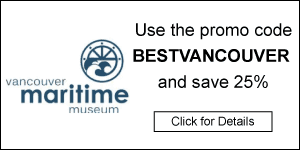
TransLink is Metro Vancouver’s main public transit system that includes buses, the SkyTrain, SeaBus and West Coast Express.
To find how to get from one place in the Lower Mainland to another, see the Trip Planning Tool on the TransLink website. To learn more about the transit company in general, see below.
TransLink Public Transit System
The TransLink public transit system services Metro Vancouver with a variety of routes and ways to get around. The SkyTrain, SeaBus, and buses are used throughout the day by Vancouverites on their work commutes and for leisure. West Coast Express trains are used at rush hour times on weekdays.
TransLink absorbed the BC Transit bus system for Vancouver a while back and created a cohesive network where one card (the Compass Card) can now be used for access to all methods of transportation. As well as using the Compass Card for payments, you can also tap a valid credit card when boarding. You can also use cash, but only on buses.
(Note: Taxis, UBER, Lyft and other commercial transportation companies are not part of TransLink and do not accept Compass Card payment.)

How the TransLink System Works
The Lower Mainland is connected by a series of transportation hubs with connections between them. Arguably the most important terminal, at least for all services other than public bus transportation, is Waterfront Station which is in the heart of downtown Vancouver and connected to all parts of the region by SkyTrain, SeaBus and the West Coast Express.
For all public transit other than the West Coast Express, the TransLink system is divided into zones. Depending on how many zones you travel through, the amount you’ll pay varies. (For travel rates on the West Coast Express see the TransLink.ca website.)
If you are only traveling by bus then you only have to pay for one zone, regardless of how far you go and the number of zones. If you’re traveling by SeaBus, on the other hand, you will be passing through two zones. By SkyTrain you might pass through one, two or three zones depending on how far you’re traveling and where you start. The cost of all bus, SeaBus and SkyTrain travel is the price of just one zone after 6:30 pm on weekdays and all day on weekends.
The Compass Card
A Compass Card is your ultimate public transit pass. When taking a bus, SkyTrain, SeaBus or even a West Coast Express train all you have to do is tap your card and the fares owed are automatically deducted from your account. You can add money to your card through a Compass Kiosk located at most SeaBus and SkyTrain terminals or online on the Compass Card website.
TransLink Buses
Many buses in the public transit system are electric and rely on overhead wire systems for their power. These systems are primarily in the City of Vancouver but there are also hybrid buses that are in use in other parts of the Metro Vancouver area.
TransLink operates over 200 bus routes in 20 different municipalities within Metro Vancouver. On an average day, the buses collectively travel over 250,000 kilometres!
Vancouver’s SkyTrain
There are three lines of SkyTrains that go to different locations. Between them, the light rapid transit system features over 50 stations that connect the City of Vancouver with half a dozen different municipalities as well as with Vancouver International Airport.
The Expo Line travels from Waterfront Station and then branches, with each section leading to either Burnaby, Surrey or New Westminster. The Canada Line goes from Waterfront Station in downtown Vancouver to Richmond and YVR Airport. Last but not least, the Millennium Line runs from Vancouver to Port Moody, Coquitlam and Burnaby.
An interesting feature of the SkyTrains is that, since they started running back in 1986, they operate with no staff or conductor on board. They are fully automated (with conductors working remotely to make sure things go smoothly)!

The SeaBus
The SeaBus is the ferry service linking North Vancouver with the downtown Vancouver area, and, by doing so, to the rest of Metro Vancouver. The ferry runs from Lonsdale Quay to Waterfront Station and it can carry up to 400 passengers at a time. The boat departs approximately once every 15 minutes and it takes about that same amount of time to cross from one side of Burrard Inlet to the other (which can be faster than driving on one of the bridges).
Journeying through Burrard Inlet, the SeaBus has captains who steer the vessel through the maze of ships and barges that harbour in the inlet. The views from the ferry are impressive!

West Coast Express
The West Coast Express is a commuter train that goes from Vancouver to Mission in the Fraser Valley with half a dozen stops in between. The rail service runs on weekdays only, during rush hour times. There are no trains on weekends and statutory holidays. On some other special dates (like Easter Monday and Christmas Eve) there are revised schedules.
Originating at Waterfront Station in downtown Vancouver, the train has stops in Port Moody, Coquitlam, Port Coquitlam, Pitt Meadows, Maple Ridge and Mission.
Trains depart once every half hour from Waterfront Station between around 6:40 am and 8:40 am, and inbound trains originating in Mission run between 5:25 am and 7:25 am. Afternoon service runs every 30 minutes from Waterfront Station from 3:50 pm and 6:20 pm, and beginning in Mission between 5:05 pm and 7:35 pm. (Note: Exact times and other details are subject to change.)
For more information about the commuter train service, see the TransLink.ca website.
Vancouver Transit Prices and Fares
As already mentioned, the amount you pay depends on the amount of zones you travel through. For the purposes of this article, we have divided up the amount you pay based on the number of zones below.
(Note: Transit rates are subject to change. Prices listed below are as of July 2024 for bus, SeaBus and SkyTrain services and for payment made by Compass Cards. Tickets paid for by cash or credit card cost extra for adults, but the same for seniors and children. Prices for the West Coast Express are different and can be found on the TransLink.ca website.)
1 Zone
- Adults – $3.20
- Concession (Seniors and Youth under 18) – $2.15
- Children (ages 12 and under) – free
- Monthly – $107.30
2 Zones
- Adults – $4.65
- Concession – $3.15
- Children (ages 12 and under) – free
- Monthly – $143.50
3 Zones
- Adults – $6.35
- Concession – $4.35
- Children (ages 12 and under) – free
- Monthly – $193.80 (or $61.35 for Concession)
There are also Day Passes available for $11.50 (or $9.05 for seniors and youth under 18) which give you the ability to travel across as many zones as you’d like. Eligible university students also qualify for U-Passes which are discounted monthly travel cards.
For more information see the page about Fares and Passes on the TransLink website.
Reasons to Take Public Transit
There are many reasons why taking public transit is a good idea. Here are some of them:
- Taking public transit is better for the environment than driving a car. Buses burn less fuel per passenger than most personal vehicles, the more people take them, the more efficient they are. Adding one more passenger requires close to no extra fuel (and thus almost no additional carbon emissions)!
- If you take public transit you don’t have to pay for parking at your final destination.
- The more that people take public transit, the less congested Vancouver’s streets become.
- You can read a book or listen to music on your earphones instead of having to concentrate on the traffic.
- At rush hour, buses often get access to priority lanes. On SkyTrains and the SeaBus there is no traffic congestion at all.
- Residents of Metro Vancouver subsidize the cost of TransLink services through property taxes and gas levies. If you live in Metro Vancouver, you’re paying for the service already. You might as well use it!
Other Information
For more information on Vancouver’s public transit system and to see schedules click TransLink Information.
For information about events and attractions you can visit using public transit, check out the following:
- Vancouver’s Top 100 Places
- Lower Mainland Festivals & Events
- The A to Z’s of Vancouver























